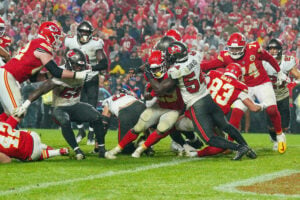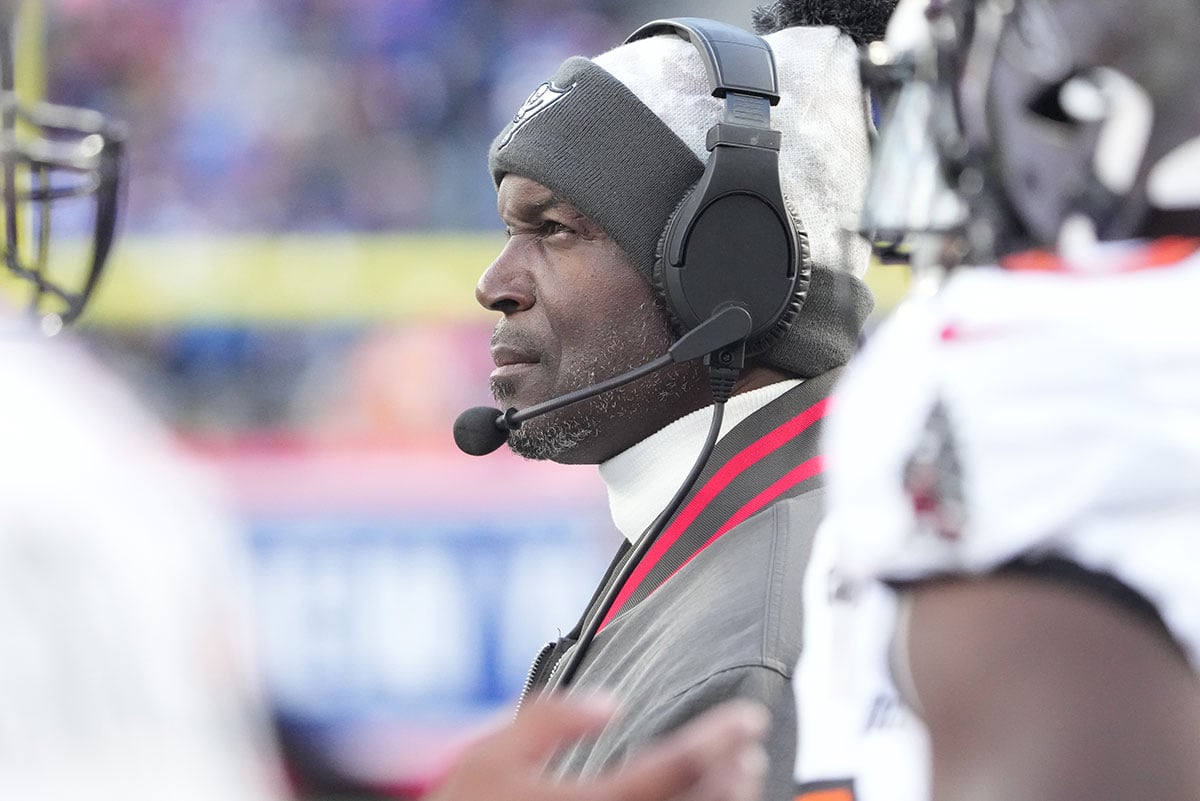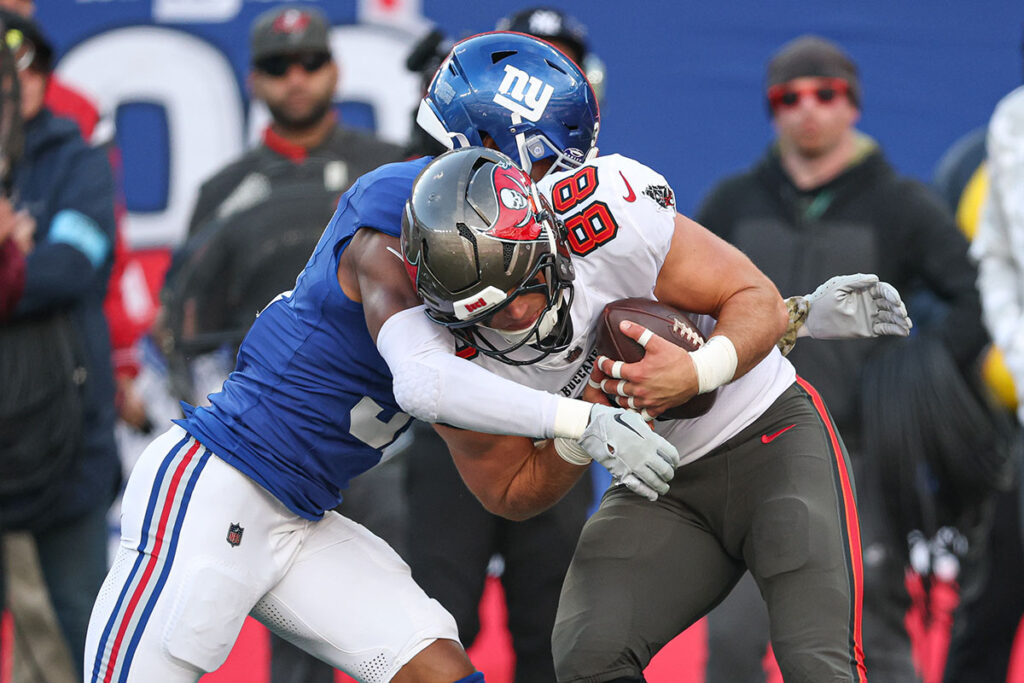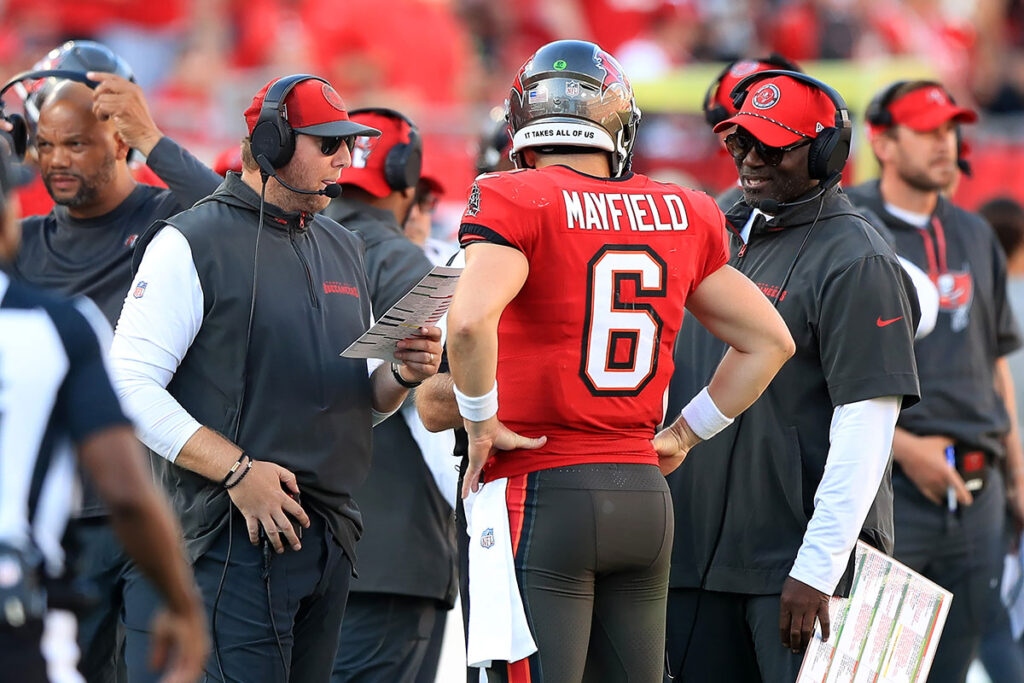The Bucs defense was once again impressive in Week 17. After a couple of early-game hiccups, Tampa Bay didn’t allow Carolina to score a single point in the second half of the game. It should be noted that since the Week 11 bye, the Bucs defense has been downright impressive. They have allowed just 16.67 points per game and top the NFL in EPA/play allowed.
All Is Not As It Seems

Bucs ILB Lavonte David and Chiefs RB Kareem Hunt – Photo by: USA Today
Most who more closely watch the Bucs know that these metrics are more mirage than manifestation. The offenses that Tampa Bay has faced have not exactly been a murderer’s row.
As measured by EPA/play the Giants have the 27th ranked offense in the NFL. The Panthers are 26th. The Raiders are 31st. The Bucs were able to manhandle the Chargers offense that is ranked 14th, but then they got embarrassed by the 29th ranked unit, and Cooper Rush-led Cowboys offense.
There have been some process-driven improvements. Head coach Todd Bowles is varying his personnel groupings to include more 5-1-5’s and 6-1-4 looks. He is leaning into the thing that his defense is best at – more on that later. The Bucs’ tackling has been better over this stretch as well, which is crucial to their success.
But make no mistake, the test will get much tougher should the team meet Week 18 expectations and beat the New Orleans Saints to vault them into the playoffs for the fifth straight season. Not a single NFC playoff team has a bottom-half offense. Using the same EPA/play measurement the Rams are ranked 13th in the NFL. The Vikings are 11th. The Packers are eighth. The Eagles are sixth. The Commanders are fourth. The Lions are third. Tampa Bay is not going to be able to feast on lesser squads.
But there are two common themes that go beyond the overall quality of the opponent that points to whether Todd Bowles’ unit will be successful or not.
The first is tackling. Bowles’ scheme requires sound tackling to prevent yards after catch because it does not ask coverage defenders to contest catches very often. Accordingly, they have to limit post-catch damage significantly. Bowles is willing to live this way because, more importantly, his defense looks to create negative plays behind the line of scrimmage to force offenses to gain more yards on those completed catches later on.
And he accomplishes this through pressure. Constant, overwhelming pressure. Through blitzing – pure, unadulterated blitzing.
And he’s been doing it even more than usual.
Todd Bowles Is Blitzing To Cover Up Back-End Deficiencies

Bucs LB Lavonte David and Raiders QB Aidan O’Connell – Photo by: Cliff Welch/PR
The book is out on the Bucs middle of the field issues. While inside linebacker J.J. Russell has played better of late and Lavonte David’s play has improved as well, Tampa Bay still has issues in coverage.
Cornerback Zyon McCollum has regressed after a strong start to the season. The Bucs’ safety-play this year has been inconsistent to be kind, and poor to be more accurate. This past week Mike Edwards and Jordan Whitehead both allowed coverage busts that resulted in touchdowns for the Panthers.
To try and limit the impact of these coverage issues Todd Bowles is blitzing more than normal to force more inaccurate throws and get more sacks. And it has largely worked. According to NFL Pro, the Bucs’ season-long blitz rate ranks third in the NFL at 36% and they have generated pressure at an almost identical rate.
Since the bye week, Bowles’ blitz rate is up to 43.4% and that pressure rate has increased 38.74%. They have averaged 2.67 sacks per game as well. This will be the crux of whether the Bucs defense can compete in the playoffs are not. They are 6-4 in games where they blitz at least 35% of the time and 3-3 when they are below that rate.
Bucs Opponents vs. The Blitz
Some teams and quarterbacks do better against the blitz and some do worse. The Bucs are set to potentially face Jayden Daniels, Sam Darnold, Matt Stafford, Jordan Love, Jalen Hurts and Jared Goff in the playoffs. How do each of these quarterbacks do under pressure? Let’s take a look.
Darnold gets pressured the most when blitzed. According to data exported from Pro Football Focus, Darnold is third in the NFL in pressure rate when blitzed at 51.66%. Only Mason Rudolph and Anthony Richardson have been pressured more when blitzed. Hurts is also in the Top 10 at 45.45%. Jayden Daniels is in the top half as well, ranked 13th at 44.39%.
The Rams, Lions and Packers all allow less pressure on blitzes. This is a combination of sound play by the offensive lines and the quarterbacks themselves. Goff ranks 28th in pressure rate when blitzed (36.97%), Love ranks 25th (37.93%) and Stafford ranks 23rd (38.33%). These offenses would present greater issues for the Bucs in terms of the Bucs succeeding in generating pressure on blitzes.
And how do those quarterbacks themselves perform against the blitz?

Bucs head coach Todd Bowles and ILB Lavonte David – Photo by: Cliff Welch/PR
The two quarterbacks who would be most susceptible to the blitz are Jordan Love and Jalen Hurts. The Bucs defense has had success against both of those quarterbacks in the last 13 months. Tampa Bay dismantled Love and the Packers Week 13 of last year before crushing Hurts and the Eagles in the first round of the 2023 playoffs. They then beat Hurts again Week 4 of this year.
Josh Queipo joined the Pewter Report team in 2022, specializing in salary cap analysis and film study. In addition to his official role with the website and podcast, he has an unofficial role as the Pewter Report team’s beaming light of positivity and jokes. A staunch proponent of the forward pass, he is a father to two amazing children and loves sushi, brisket, steak and bacon, though the order changes depending on the day. He graduated from the University of South Florida in 2008 with a degree in finance.




